|
Introduction
ROYAL STYLE: QING DYNASTY AND WESTERN COURT JEWELRY
Jewelry is not only appreciated for its gorgeous, glittery radiance, but is also used to reveal the nature and demeanor of its wearers. From the latter association and the contexts in which it has historically been worn, jewelry has become a cultural symbol representing the identity and power of the wearer. In fact, it was so consistently and deliberately utilized to these ends throughout time that it developed a vocabulary of its own. And because imperial jewelry is embedded with signifiers of royal status, new socialites and merchants would enthusiastically imitate court styles in order to share the unparalleled glory. Against this backdrop, the market for jewelry for the upper classes expanded and demanded innovative designs that were comparable to those produced for the court.
From ancient times to the present, jewelry and its patrons have mutually reflected and benefited from each other’s splendor, with personal adornment transcending the boundaries of gender and culture. Over time, variations in jewelry style, technique, and manner emerged. In periods of interaction between the East and the West, for instance, the possibilities for materials, techniques, and designs expanded, leading to more diverse jewelry styles and imbuing the pieces with deeper cultural meaning.
The main theme of the exhibition is the story of jewelry and its patrons, which is presented by a comparison between the jewelry of the Qing court and that of the Western nobility. The imperial style will be introduced first in order to show the classic model of jewelry. This will be followed by the theme of contemporary fashion. The concurrent artistic developments in these two markets can be seen throughout the exhibition. The final section will present the ways in which East and West encountered one another at different points and places in time, their incorporation of elements from each other’s cultures, and the magnificent fruits that were born of this contact. The exhibition is composed of 470 pieces of jewelry from the collection of the National Palace Museum and special loans from the Cartier Collection and the Shenyang Palace Museum, which together present the colorful and fascinating culture of jewelry.
|

|
|
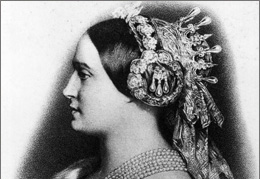 |
Queen Alexandra of Great Britain wearing a latticework platinum and diamond-set necklace, commissioned by Buckingham Palace from Pierre Cartier in 1904. Portrait by François Flameng, 1907.
© The Royal Collection, Windsor |
|
Princess Mathilde (1820-1904), niece of Napoleon I and a fervent admirer of Cartier, introduced the jeweler Cartier to Empress Eugénie in 1859. Cartier's registers record almost two hundred items of jewelry sold to Princess Mathilde.
© Collection Roger Viollet |
 |
|
 |
Elisabeth, Queen of the Belgians, wearing a platinum and diamond-set Garland style tiara, created for her in 1910.The tiara belongs to the Cartier Collection and is part of the exhibition. (Scroll tiara)
© Collection C. Boulay / Cartier |
|
Queen Mary of Romania wearing a Cartier platinum, diamond- and sapphire-set tiara which once belonged to Grand Duchess Maria Pavlovna, 1920. Cartier Archives © Cartier |
Qing Court Jewelry
The jewelry of the Qing court was not designed to simply express the beauty of the materials – for this aspect only relayed the extravagant wealth and superficiality– but instead their moral connotations. The Dong pearls, for instance, were highly esteemed for coming from the ancestral homeland of the Manchus. Lapis lazuli, fossil resin in the color of beeswax, coral and turquoise, likewise, were used to worship the deities of heaven, earth, sun and moon and on account of metaphoric associations between materials and colors. The motifs and designs of ornaments often conveyed auspicious and celebratory meanings, such as wishes for good fortune, longevity and safety.
The rarity and translucence of gems was, in fact, not the most important consideration for jewelry. Instead, argarwood, fruit pits, Bodhi seeds, and other plant materials were frequently used for their unique fragrances and for specific religious significance. Furthermore, the brilliant color of kingfisher feathers was favored by court ladies. Gold, equal to the value of currency, was always the most beloved material of the Chinese people.
In the development of the jewelry in the Qing court, pieces produced for ritual use were made according to specific standards that were strictly adhered to and were unchanging. By contrast, so long as they did not violate Manchu traditions, women’s daily ornaments became increasingly splendid and opulent. The jewelry of the Qing court reveals diverse styles through its adoption of certain elements of the Han Chinese costume on the one hand, and through using western materials like enamel and glass and employing the western techniques of lapidary and inlay on the other. The following three sections—Imperial Rites, Unparalleled Elegance, and East meets West—give you a glimpse of the jewelry of the Qing court.
Imperial Rites
In the Pictorial Catalogue of Imperial Ritual Implements, compiled under Emperor Qianlong’s reign and published in 1777, four volumes are dedicated to the regulation of appropriate costumes for the imperial family and officials according to their status, various offering rituals and celebrations. To formulate and convey the superiority and grandeur of the imperial family, they incorporated aspects from other ethnic groups into Manchu traditions. Thus, colorful precious stones, gleaming gold, and rare jewels were used in traditional Manchu motifs in specific compositions to visually manifest the exalted status of the imperial patrons.
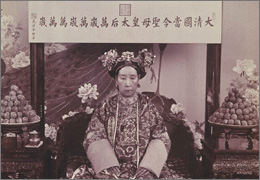 |
|
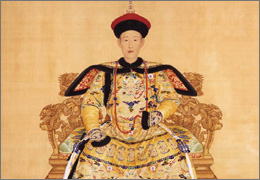 |
Photograph of the Empress Dowager Cixi (1834-1908) in Festive Court Attire Qing Dynasty (1644- 1911)
The Palace Museum |
|
The Qianlong Emperor in Formal Court Attire. Giuseppe Castiglione (Lang Shining), (1688-1766) 1735, Qing Dynasty (1644- 1911)
The Palace Museum |
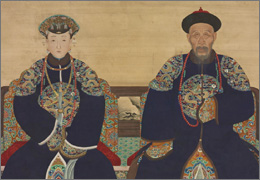 |
|
 |
Portrait of Yinti, Prince Xun (1688-1755), and Wife Anonymous Qing Dynasty (1644- 1911)
Freer Gallery of Art |
|
The Empress Xiaoxianchun in Formal Court Attire Anonymous Qing Dynasty (1644- 1911)
The Palace Museum, Beijing |
 |
|
|
Portrait of the Qianlong Emperor and Empress in Festive Court Attire Giuseppe Castiglione (Lang Shining), (1688-1766) 1736, Qing Dynasty (1644- 1911)
The Cleveland Museum of Art |
|
|
Unparalleled Elegance
In the Qing dynasty, the Manchu people formed into a distinct group in society. In daily life, Manchu women wore a particular hairstyle, known as liangbatou (two-bundle hairstyle), which was adorned with various hair ornaments and pins. It was also common for both men and women to wear hanging from the breast of their clothing a rosary, which reflected their belief in Tibetan Buddhism. The use of gold filigree in the early Qing, the increasingly prominent use of kingfisher feathers in designs of the Daoguan reign(1821-1850), and the jewel inlays and rosaries of the Tongzhi reign(1862-1874), all reflect jewelry fashions in the Qing dynasty and the unparalleled elegance of women’s ornamentation at that time.
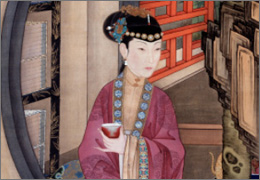 |
|
 |
Beauties: "Appreciating Tea" Anonymous Qing Dynasty (1644- 1911)
The Palace Museum, Beijing |
|
Beauties: "Doing Needlework" Anonymous, Qing Dynasty (1644- 1911)
The Palace Museum, Beijing |
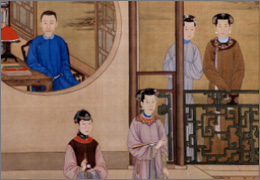 |
|
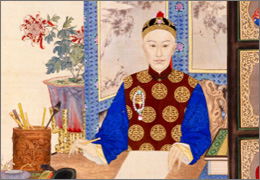 |
The Yongzheng Emperor's Amusement (Detail) Anonymous Qing Dynasty (1644- 1911)
The Palace Museum, Beijing |
|
Portrait of the Guangxu Emperor in Informal Dress Anonymous Qing Dynasty (1644- 1911)
The Palace Museum |
 |
|
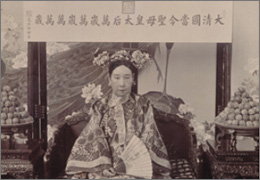 |
| Portrait of the Empress Xiaozhen in "Qifu" Banner Attire Anonymous Qing Dynasty (1644- 1911) |
|
Photograph of The Dowager Empress Cixi (1834-1908) in "Qifu" Banner Attire Qing Dynasty (1644- 1911) |
East meets West
As early as the late Ming and early Qing dynasties, when the Chinese and Europeans were in frequent contact, Oriental jewelry readily incorporated Western techniques and designs. This is most clearly expressed on chime clocks. As seen on these clocks, translucent glasses were transformed into colorful gems, sparkling diamonds were introduced, and bright enamel and Western scroll patterns constantly appeared. With the opening of trading ports in the early twentieth century, Western elements were increasingly adopted into Oriental jewelry, as evidenced by that of the last imperial couple, Puyi and Wanrong.
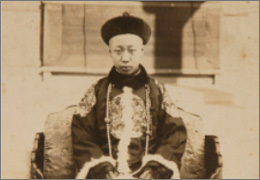 |
|
 |
Photograph of P'uyi during Restoration 1917
The Palace Museum, Beijing |
|
Photograph of P'uyi at His Wedding 1922
The Palace Museum, Beijing |
 |
|
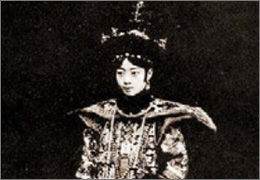 |
Photograph of Empress Wanrong
National Palace Museum |
|
Photograph of Empress Wanrong in the Wedding Attire at Her Wedding
The Palace Museum, Beijing |
Western Court Jewelry
In 1539, François I issued a decree which stipulated the inalienability of the most important French crown jewels, notably the precious gem stones, preventing their sale or that a monarch passes them on while he is alive. Upon his death, his wife was to return her jewels to the royal treasury. The jewels of the courts of Europe are the symbol of the country’s power. When Louis XIV of France, the Sun King, received foreign ambassadors in his palace at Versailles, he was decked out in his most impressive jewels and his finest clothes. This pomp impressed all of Europe’s rulers: they took the court at Versailles as their model.
For most of the 18th century the kings, princes and nobles wore as much if not more jewelry than their wives: paintings show them wearing ear-rings, necklaces and brooches. In the 19th century, however, they did not wear jewelry anymore. Instead, they were accompanied by a ceremonial sword, military insignia, buttons or shoe buckles set with diamonds. This new custom expressed the reality of strength and might as instruments of creating the states of Europe. It became customary for women to display their parures as visual evidence of their husbands’ power. It is also in the 18th century that Parisian jewelers reached international fame. New motifs such as garlands, festoons, swags and tassels inspired by tapestries and trimmings appeared and complemented the existing floral and animal motifs.The French Revolution in 1789 put an end to the splendor of the French court. After years of war and terror, General Bonaparte proclaimed himself Emperor of France in 1804 and took the name Napoleon I. Like Louis XIV, he used jewelry as a powerful vehicle to display his supremacy and set out to revive the luxury business. If the new furniture, silks, paintings and sculptures contributed to the symbolic legitimization of the sovereign, the renaissance of fashion together with precious accessories and jewelry were essential instruments of the celebration of power.
The history of France and her traditions of splendor considerably influenced the jewelers of the 19th century, among whom were the House of Cartier. Inspired by the art and the jewels of the court of the 18th century, Cartier created new jewelry, refined in taste, in the “Garland Style”, giving it a particular virtuosity and elegance, thanks to the pioneering use of platinum.
Symbol of Nobility
Founded in 1847 by Louis-François Cartier at 29 Rue Montorgueil in Paris, the House of Cartier prospered during the Second Empire (1852 – 1870) and soon moved to the Boulevard des Italiens at the heart of the Palais Royal district. Cartier quickly counted prominent members of the European and Russian aristocracies among his clients. Princess Mathilde, niece of Napoleon I and cousin of Emperor Napoleon III, and the latter's wife, Empress Eugénie, soon followed suit. The success of the House as well as an increasingly international clientele led Alfred, the founder's son, to open a branch in London in 1902, followed by New York in 1909. Each location was to be managed by one of Alfred's three sons: Louis in Paris, Pierre in New York and Jacques in London.
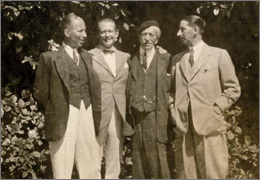 |
|
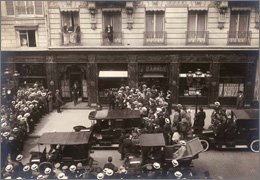 |
Family portrait of Alfred Cartier with his three sons, Pierre, Louis and Jacques, in Saint-Jean-de-Luz in 1922.
Cartier Archives © Cartier |
|
King Alfonso XIII of Spain visiting Cartier Paris in 1920.
Cartier Archives © Cartier |
King Edward VII (1901 – 1910) exclaimed: "Cartier – jeweler of kings; king of jewelers!" Between 1904 and 1939 Cartier obtained 15 royal warrants, amongst them the royal houses of England, Spain, Belgium and Romania. Following in the wake of their sovereigns, the nobility ordered sumptuous jewels from Cartier, which allowed them to demonstrate their status in high society and to honor their monarchs at official events. Cartier also catered to the rich maharajahs of India who were anxious to show their power with their parade jewelry.
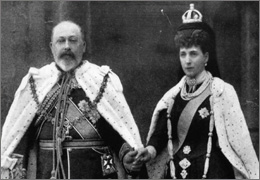 |
|
 |
King Edward VII and Queen Alexandra of England, circa 1902.
Cartier Archives © Cartier |
|
In 1904, Cartier was appointed official supplier to the Court of England and granted a royal warrant by King Edward VII.
Cartier Archives © Cartier |
The tiara is the jewel most symbolic of its wearer's status. De rigueur for the ladies of the nobility at official events where the monarch is present, it has been subject to infinite variations in design, ranging from the "Garland Style," named after Cartier's Belle Époque motifs inspired by the 18th century, to a modern style and Art Deco. It also forms part of the wedding casket and Cartier, whose address since 1899 has been at 13 Rue de la Paix, was famed to create the most elegant ones.
 |
Princess Marie Bonaparte wearing her platinum and diamond-set olive leaf tiara commissioned for her marriage to Prince George of Greece and Denmark in 1907.
Cartier Archives © Cartier |
The Power of Style
During the 19th century the foundations of a newly emerging social class are laid: a class of industrialists and businessmen primarily from the Unites States of America but also Europe. Their fortunes were considerable, surpassing even those of the aristocracy and royal families. The kings of this new world were called Astor, Vanderbilt, Morgan, Ford…These new clients did not hesitate to cross the Atlantic twice a year aboard the sumptuous ocean liners to get the latest Parisian creations. Cartier was an equally obligatory stop and their jewels marvelously matched the opulent silken evening gowns of the Belle Époque.
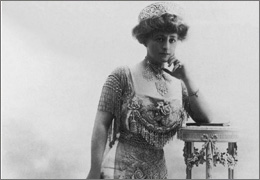 |
|
 |
Mrs Cornelius Vanderbilt wearing her Cartier diamond necklace and a 19th century "rose" brooch that once belonged to Princess Mathilde. Mrs Vanderbilt purchased the brooch from Cartier in 1904.
Cartier Archives © Cartier . |
|
View of Place Vendôme, circa 1905.
© ND/Roger-Viollet |
Heirs and, more often, heiresses of the great American fortunes and the grandest aristocratic European families gave birth to a new elite: one that was rich, cultivated, open-minded, audacious, sometimes even provocative, and with a sense for business. This group became known as the Café Society. It represented a melting pot of literature, music, dance, fine art, but also cinema, photography, fashion, and interior decoration.
 |
|
 |
Cecil Beaton, Alexis de Rédé and Daisy Fellowes at a dinner at Hôtel Lambert, the home of Baron Alexis de Rédé, 1950. Other guests included Princess Ghislaine de Polignac, Princess Simone Troubetzkoï and Tony Gandarillas.
© Robert Doisneau |
|
The Duke and Duchess of Windsor in 1958.
© Philippe Halsman/Magnum Photos |
The Duchess of Windsor quickly turned into one of the core members of the Café Society; her rivals were Daisy Fellowes, Countess Mona Bismarck, Pauline de Rothschild or Gloria Guinness... These "icons" invested their time, energy and money to be the world's most elegant women. The refined Jeanne Toussaint, head of Cartier's fine jewelry from 1933 to the 1960s was able to deal with these strong-willed and sometimes audacious, formidable women, forging close relationships with the likes of these increasingly bold, demanding clients.
East Meets West
The dialogue between Europe and the East is one of the most fascinating chapters in the history of design. The arts of the Far East inspired Louis Cartier and his draughtsmen to create some outstanding works of art: clocks, decorative objects, and jewels. The Art Deco period also saw a huge surge in popularity for vanity and cigarette cases as well as decorative boxes. Some of them were adorned with laque burgauté plaques imported from China, and Japan. Cartier’s jewelry often incorporated antique Chinese jade and agate sculptures. Moreover Chinese motifs and symbols often inspired diamond jewelry.
The Mediterranean and Islamic arts fascinated Louis Cartier who had built up a fine collection of Persian miniatures. They had an influence on designs starting in the 1910s and would evolve into one of the defining characteristics of Art Deco. It was the unusual combination of non-European ancient art and modern mounts that led Cartier to a unique creative expression in jewelry in the 1920s.
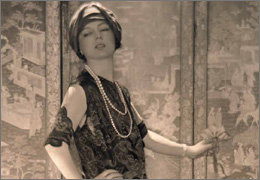 |
|
 |
Jeanne Toussaint photographed by Baron Adolph de Meyer, circa 1920.
© Baron Adolph de Meyer / Cartier Archives |
|
Invitation in the Indo-Persian style card to an exhibition of oriental jewels at Cartier London in 1912.
Cartier Archives © Cartier |
With the discovery of King Tutankhamen's tomb in 1922, Egypt became an inspiration for the fine arts, fashion, literature, and cinema. Fragments of Egyptian antiquities, acquired by Louis Cartier from specialized antique dealers,were incorporated into brooches or vanity cases.
Of all non-European artistic legacies, the decorative arts of India and Persia exerted the strongest influence on Cartier's jewelry designs. In 1911 Jacques Cartier traveled to India and saw for himself the popularity of Parisian jewels and watches among the maharajas. They asked Cartier to transform their jewels into new creations, and this contact with India inspired Cartier to design his magnificent Indian-style parures and his multi-gem-set jewels that were to become known as Tutti Frutti.
 |
|
 |
Fragments of Egyptian art ranging from 1000 BC to 500 AD get a new life: brooches, pendants, earrings and hat pins set with real antiques and a Tutankhamen replica. All by Cartier. The discover of Tutankhamen's tomb in 1922 by Howard Carter triggered a craze for Egyptian-inspired fashion and jewelry.
© Illustrated London News Ltd/Mary Evans |
|
Photo taken from Jacques Cartier's journey book documenting his travels to India in 1911.
Cartier Archives © Cartier |
Selections
National Palace Museum, Shenyang Museum

|
|
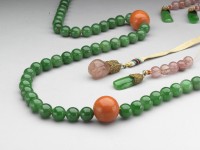
|
|
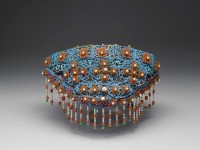
|
Summer Court Hat for Imperial Concubines
Qing dynasty (1644-1911)
Gold, Oriental Pearls, dark blue velvet, and vermilion silk cord fringe
External diameter: 31.5 cm, overall height: 31.5 cm
National Palace Museum Collection
|
|
Court Necklace with Green Jadeite Beads
Qing dynasty (1644-1911)
Green jadeite, coral, tourmaline, gilt copper, and kingfisher feathers
Perimeter: 145 cm; diameter of beads: 1.2 cm
National Palace Museum Collection
|
|
Gilt Headdress in Kingfisher Feathers with Chinese Character "Double Happiness"
Qing dynasty (1644-1911)
Gilt copper, kingfisher feathers, coral, and pearls
Length: 32 cm, width: 19 cm, height: 17 cm
National Palace Museum Collection
|

|
|

|
|

|
Belt and Gilt Buckle with Floral Design Inlaid with Diamonds
Early Qing period
Gilt copper, sapphire, ruby, green jade, and pearls
Length: 98.5 cm, maximal width: 10.6 cm
National Palace Museum Collection |
|
Finial of Hat with Ruby Inlay
Qing dynasty (1644-1911)
Gilt copper, ruby, and kingfisher feathers
Diameter of base: 4.36 cm, overall height: 11.5 cm
National Palace Museum Collection |
|
Gold Headdress Ornament with Water Chestnut Floral Design Inlaid with Diamonds
Early Qing period
Gold, diamond, Oriental Pearls, ruby, and kingfisher feathers
Length; 10.8 cm, width: 4.85 cm
National Palace Museum Collection |
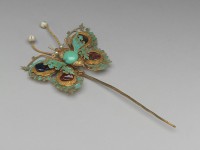
|
|

|
|

|
Gold Hairpin with a Butterfly-shaped Finial in Filigree
Early Qing period
Gold, rubies, sapphires, turquoise, Oriental Pearls, and kingfisher feathers
Overall length: 17.3 cm, width: 8.5 cm
National Palace Museum Colelction |
|
Gilt Hairpin with Design of Squirrels and Grapes
Middle Qing period
Gilt silver, Oriental Pearls, ruby, sapphire, tourmaline, green jadeite, and kingfisher feathers
Length: 21.5 cm, width: 8.7 cm
National Palace Museum Collection |
|
Sable Hat Decorated with Patterns of Ruyi Clouds and Florals and a Red Velvet Knotted Finial; Silk Pendant with Dragon Design
Qing dynasty (1644-1911)
Sable, tourmaline, green jadeite, oval-shaped pearls, silk pendant
Hat: diameter: 23 cm; overall height: 12.5 cm; pendant: 91 cm
National Palace Museum Collection |
Cartier Collection
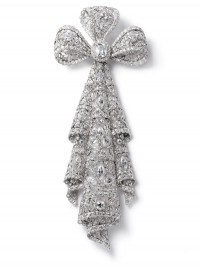
|
|
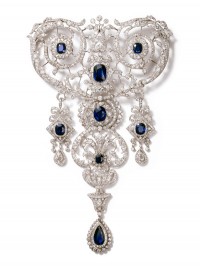
|
|

|
Lace Ribbon Brooch
1906
Platinum, gold, cushion-shaped, marquise-cut, round old- and rose-cut diamonds, millegrain setting and collet-setting
17.1 x 6.45 cm
Cartier Collection |
|
Stomacher Brooch
1907
Platinum, one pear-shaped sapphire, seven cushion-shaped sapphires, round old- and rose-cut diamonds
The total weight of the sapphires is approximately 51 carats.
21.0 x 12.9 cm
Cartier Collection |
|
Scroll Tiara
1908
Silver, gold, cushion-shaped, round old- and rose-cut diamonds, millegrain setting
Height at centre 8.05 cm
Cartier Collection |

|
|
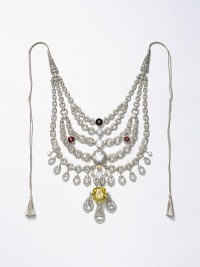
|
|
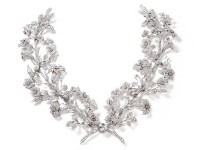
|
Rose Clip Brooch
1938
Platinum, baguette-, round old- and single-cut diamonds
7.32 x 4.32 cm
Cartier Collection |
|
Necklace
1928
Platinum, old- and rose-cut diamonds (chain and links), one cushion-shaped yellow zirconia, four white zirconias, thirteen white topazes, two synthetic rubies, one smoky quartz, one citrine.
Height at centre: 27.0 cm
Cartier Collection |
|
Lily Stomacher Brooch
1906
Platinum, round old- and rose-cut diamonds
Length of each branch: 23.0 cm
Cartier Collection |

|
|
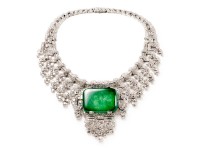
|
|
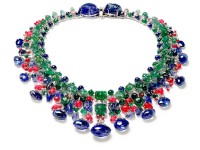
|
Tiara
1905
Platinum, seven pear-shaped diamonds, weighing approximately 17 carats in total, old- and rose-cut diamonds millegrain setting
Height at centre 9.8 cm
Cartier Collection |
|
Necklace
1932
Platinum, round old- and rose-cut diamonds, one cushion-shaped polished 143.23 carat emerald
Height at centre: 8.80 cm
Cartier Collection |
|
Tutti Frutti Necklace
1936
Platinum, white gold, marquise-, baguette- and round old-cut diamonds, thirteen briolette-cut sapphires weighing 146.9 carat in total, two leaf-shaped carved sapphires (50.80 and 42.45 carats), sapphire beads.
Length: 43.0 cm (open)
Cartier Collection |
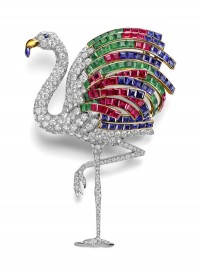
|
|
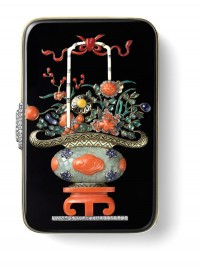
|
|
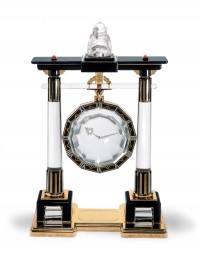
|
Flamingo Brooch
1940
Platinum, gold, brilliant-cut diamonds, square emeralds, sapphires and rubies, sapphire cabochons, one citrine
9.65 x 6.59 cm
Cartier Collection |
|
Vanity Case with Chinese Vase Decoration
1927
Gold, platinum, carved emerald, emerald and sapphire cabochons, onyx, coral, single- and rose-cut diamonds, red, ivory-coloured, black, green and yellow enamel
9.0 x 5.9 x 2.5 cm
Cartier Collection |
|
Large Portique Mystery Clock
1923
Gold, platinum, rock crystal dial, columns and Billiken figure, rose-cut diamonds, coral cabochons, onyx, black enamel
35.0 x 23.0 x 13.0 cm
Cartier Collection |
Text and images are provided by National Palace Museum
|
































































